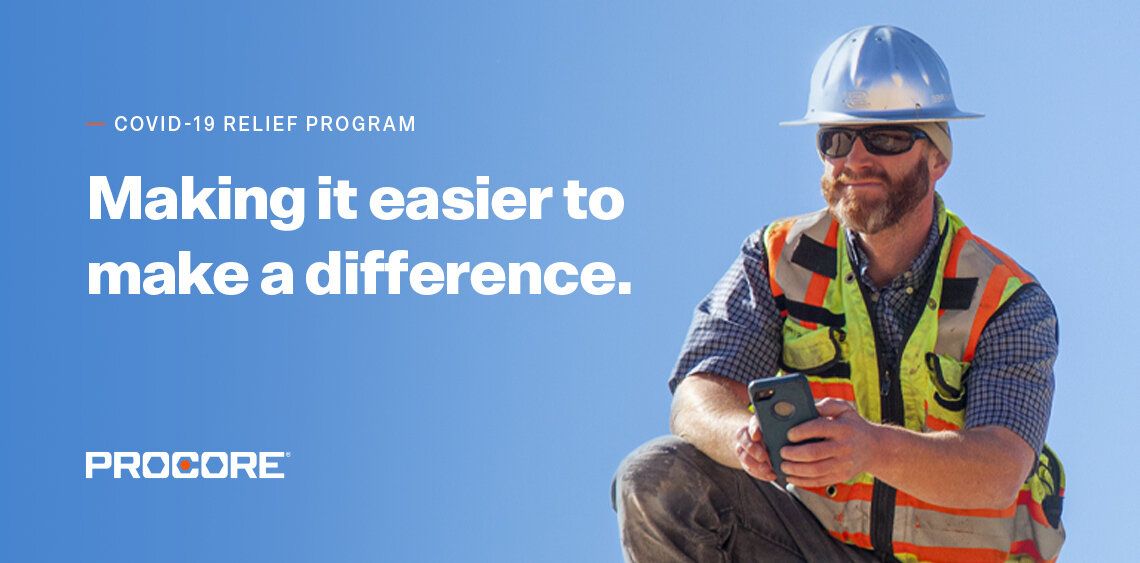There are still many jobsites that continue to stay open during the Coronavirus Pandemic, even though certain states, cities, and contractors have temporarily shut down various jobs throughout the country. For those employers that have chosen to continue to work, you have the responsibility to inform and protect your workers from jobsite hazards, including potential spread of the virus.
Read moreOSHA Issues Guidance For Respirators in Response to N95 Mask Shortage
As you are probably well aware, the US is facing a shortage of N95 rated masks during the Coronavirus Pandemic, which is not only affecting the hospital staffs that desperately need them, but construction workers who need to protect their lungs during essential work.
Read moreProcore Offering Free Software Access for COVID-19 Related Projects
courtesy of Procore
As jobsites continue to be shut down throughout the country and office staff has been working remotely during the coronavirus pandemic, more and more construction companies are relying on technology to help keep them afloat. Many companies and projects have also begun shifting into different roles, some even to help provide more facilities for healthcare and manufacturing to help in relief as the virus spreads.
Read moreKey Takeaways from Briq’s COVID-19 & Construction Panel Discussion
There has been a ton of uncertainty surrounding the Coronavirus pandemic that is currently shutting down the entire continental United States and the information seems to be changing by the minute. To help navigate your construction businesses through this mess, the team at Briq hosts an expert panel discussion yesterday titled “The War Room: A Construction Disaster Preparedness Panel.”
Moderated by the CEO of Briq, Bassem Hamdy, the panel featured:
Moti Jungreis, Vice Chair and Head of Global Markets, TD Securities
Cal Beyer, Vice President, Workforce Risk and Mental Well-being, Cobb Strecker Dunphy Zimmerman (CADZ)
James Benham, CEO, JBKnowledge
I want to give a brief overview of the discussions that took place, but you can watch the full replay of the hour long discussion on Briq’s website here: https://www.br.iq/the-war-room-panel
Overall Effect on the Economy
Jungreis led off the discussion by explaining the overall impact the pandemic has had on the economy so far, drawing comparisons to the post-9/11 recession and the 2008 housing collapse. He stressed that unlike those two events, the banks were in strong financial standing prior to the shutdowns and are “not going to walk away from credit lines.” He said that the difference between a deep recession versus a shallow depression will be the ability to help small businesses recover.
Learning from the Past
James Benham talked about his experiences navigating through the 2001 and 2008 downturns and stressed the need to trim non-essential expenses in order to retain critical staff through your hardest times. His number one rule of business is to just survive and to find a way to keep your business operating, which could mean pivoting into different, but related, work, like service work instead of new builds.
Working Remotely
Being a technology guru, Benham also shared insights on the best practices for working remotely and some readily available software to help get you through it. Programs like Microsoft Teams, Slack, WhatsApp, and Zoom will help keep your teams in productive communication while working remotely. He says that his favorite app for internal meetings is Teams, whereas he prefers Zoom for external meetings. WhatsApp is his favorite for mobile.
Lean On Your Peer Groups
Both Benham and Beyer talked about keeping in touch with your peer groups to help get navigate through hard times. Using the software mentioned above, you don’t have to cancel in person meetings, just move to web meetings. Use these peers to bounce ideas off of and gain valuable insights from their past experiences.
Employee Mental Health
Beyer discussed the challenges of dealing with the mental health of employees, who may be experiencing additional stress related to money or health. He said that it’s pivotal for your company to exhibit a caring culture and to “recognize and acknowledge that these rapidly changing conditions are going to create stress and anxiety.” He also said that keeping communication lines open and developing a business continuity plan can help ease concerns.
Find the Opportunity
If you have set your company up for success by practicing fiscal conservatism, this economic downturn can prove fruitful if you know where to look. Benham touched on his past experiences when he was able to hire key staff from other companies that laid them off, or find equipment at a great price.
Job Site Shutdowns
Attendees on the call expressed concern about potential job site shutdowns and Hamdy said that your company needs to be prepared for them. Since the call happened, the Mayor of Boston had shut down all of the city’s construction projects citing a recent increase in Coronavirus cases. There may be more on the way, as the count continues to rise throughout the rest of the country.
Panel of Construction Experts Hosting a Disaster Preparedness Webinar TODAY!
In light of the uncertainty surrounding the COVID-19 pandemic affecting the world, construction companies need to start developing their response plan, if they haven’t already. A team of experts has been assembled by construction technologist, Briq, and they will be hosting a webinar TOMORROW, Monday, March 16, 2020.
Read moreA List of All of the OSHA Required Construction Training Topics
A snippet from Safasite’s guide “How to Comply with OSHA Safety Training Standards”
As all construction professionals should know, OSHA requires formalized training on various construction tasks on an annual or periodic basis. It can be difficult to locate and document all of the requirements, but the team at Safesite has just released a handy guide on their website to make it a whole lot easier.
Safesite’s article titled “How to Comply with OSHA Safety Training Standards” covers all of the OSHA training requirements, not just the construction standards, but it’s organized so you can jump to the most pertinent topics.
In addition to listing the specific regulation standards that OSHA requires training on, the guide also covers proper documentation and instruction requirements, training tips, and OSHA’s Outreach Training Program.
Keep in mind that these training requirements are on the Federal level, so your state may have even more strict training requirements. For example, California requires additional training above and beyond Federal and Maryland has tougher standards for heavy equipment training, according to the guide.
In total, there are 19 construction tasks that require initial training and annual refresher training, with 2 of those coming from the OSHA 1910 general industry standards (Access to Employee Exposure and Medical Records – 1910.1020 and Portable Fire Extinguishers – 1910.57). One of the 19 standards, Operation of Powered Platforms – 1926.66 requires bi-annual training for those that use them.
An additional 28 construction tasks are required to be completed in initial training and periodic or as-needed follow-up training. 4 of those 28 come from the OSHA 1910 general industry standards, including Aerial Lifts – 1910.67, Portable Fire Extinguishers – 1910.157, Servicing of Multi-Piece and Single-Piece Rim Wheels – 1910.177, and Toxic and Hazardous Substances – 1910 Subpart Z. Another regulation outside of the construction standards is the General Duty Clause, which covers New Employee Orientation.
For the full list and even more helpful information about safety training requirements, check out the full guide here: safesitehq.com/osha-safety-training
5 Exoskeleton Manufacturers Looking to Change the Way Tradespeople Work
via Levitate Technologies, Fraco, and Ekso Bionics
There’s no doubt that working on a construction site is hard work. Between lifting and carrying heavy materials, to using tools in overhead and other awkward positions, the barrier of entry to this industry can be a daunting task. By many accounts, this barrier is greatly contributing to the labor shortage.
Read moreAutodesk and AGC Team Up to Provide Custom Fitted Safety Harnesses for Women
[updated 3/3/20] Back in September, Skanska announced that they had partnered with PPE manufacturers to create better fitting safety vests and safety gloves for women on the job site. This week, technology giant Autodesk and the Associated General Contractors of America (AGC) announced a partnership to supply custom-fitted safety harnesses for women.
Read moreA Simple Guide for Not Getting Someone Killed in a Trench Collapse
photo by Andy Rogers, CC BY-SA 2.0
Trenching and excavation hazards are one of the most simple issues to eliminate on the construction job site, yet, every year, dozens of workers are buried alive or badly injured by collapses. Why? Mostly laziness or pure ignorance.
Read moreA Guide for Staying in Compliance with OSHA’s Recordkeeping Requirements
I just recently posted a yearly reminder for contractors of a certain size to electronically file their OSHA form 300A with the government. The electronic reporting of that form is only a portion of all of the recordkeeping requirements your company might be responsible for, so to help with that, Safesite has published “A Short Guide to OSHA Recordkeeping Requirements” on their website.
Read more





















Shane is the creator of Construction Junkie and an active construction project manager. In his career, he has managed interior remodel projects, site development, construction safety, governmental project compliance, and facility maintenance. He has a strong passion for construction technology and safety, as well as sharing the knowledge or insights he has gained throughout his career.